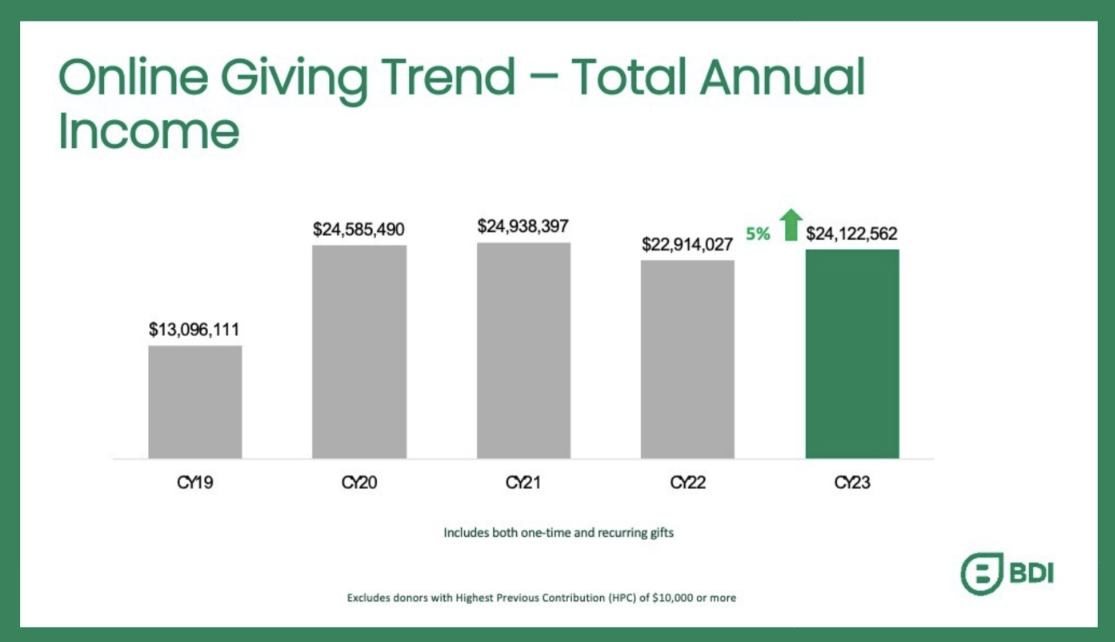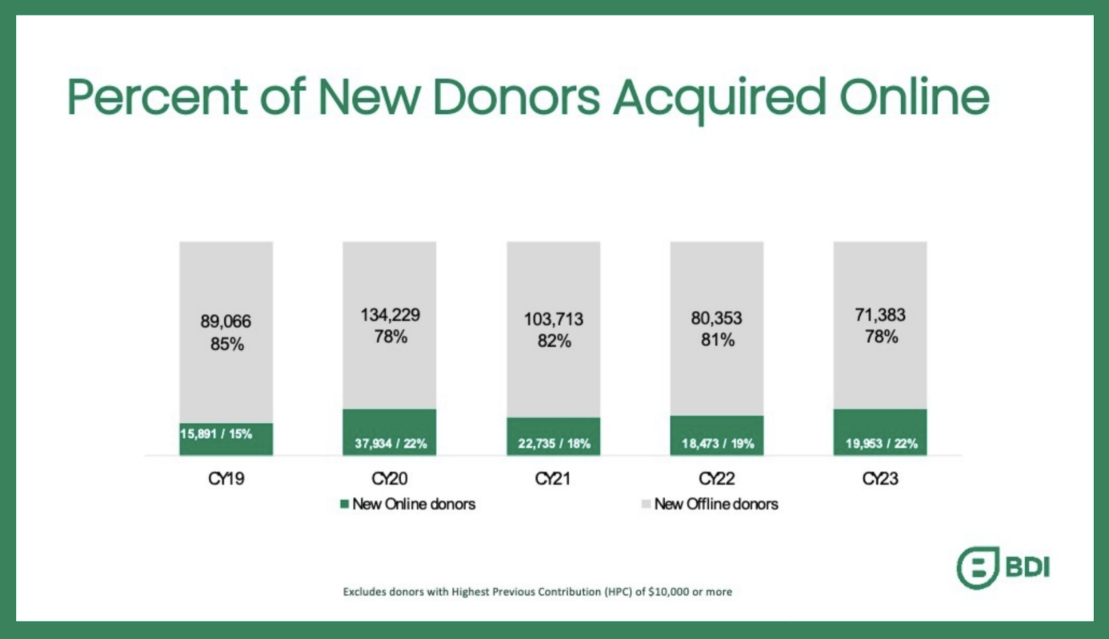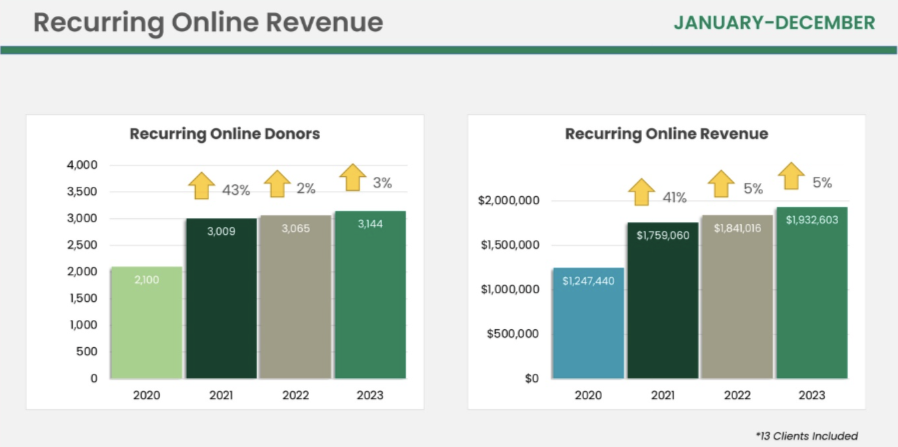Data insights and quick tips to strengthen your digital fundraising
From Stephanie Tippitt, Senior Vice President, Digital Strategy, BDI
As digital marketers, it can often feel like we’re participating in an ever-changing obstacle course. Just as we find our rhythm, keeping pace with the latest platform or tool, technology changes and we have to quickly innovate. It’s part of the challenge… and part of the excitement!
In the evolving landscape of nonprofit fundraising, staying ahead of digital trends is not just beneficial – it’s essential. At BDI, we are constantly testing, measuring and optimizing our digital strategies and campaign performance for our nonprofit client partners.
That’s why I want to share some of the highlights of our latest digital fundraising data – particularly 2024 online giving trends. Let’s take a look at these insights and some quick tips that can help nonprofit teams harness the power of digital fundraising to strengthen their development programs.
The Current State of Online Giving
In BDI’s recent Annual Missions Benchmark Report, we observed a 5% year-over-year increase in online giving. This uptick is encouraging, especially in light of the slight decrease of 1% reported across the nonprofit sector, according to the latest M+R benchmark report. This data underscores the importance of investing in digital strategies to fuel sustained revenue growth.

Also of note, 20% of new donors are acquired online by BDI’s client partners. And we expect to see this number grow! Nonprofits should continue to build their digital presence and complement their offline fundraising with digital strategies in all channels.

You may be wondering how current privacy and data rules are impacting digital fundraising and online giving. Well, there’s good news for digital marketers! Google is delaying the deprecation of cookies. While this is no time to sit back and relax, it does offer nonprofits additional time to refine their tracking strategies and ensure data accuracy when third-party cookies are eventually phased out in 2025.
The Power of Recurring Revenue
The number of recurring donors and revenue for BDI client partners with concerted digital efforts shows steady growth over the last three years.
Another encouraging trend is that BDI’s digital program participants report that recurring revenue constitutes 25% of online income. This tells us that digital strategies and sustainer programs are working well hand-in-hand.

In fact, including monthly giving prompts on donation pages have led to as much as a 30% increase in new sustainer donors for BDI client partners! Several donation platforms offer these monthly giving nudges, so be sure to check if your platform offers it.
Sustainers not only provide consistent revenue to your organization, but also strong retention rates. Among BDI’s client partners, sustainers have a retention rate of 66.8%!
Remember: Sustainers also have greater potential to upgrade to higher levels of giving as Middle and Major donors, so it’s important to have an integrated strategy for their cultivation, across online and offline channels.
Digital Growth Quick Tips
With these results highlights in mind, let’s explore some quick tips that can help you strengthen your digital fundraising program and leverage the 2024 online giving trends.
- Launch Text to Give
Enhance your cultivation strategy with this powerful tool that meets donors where they’re most active – their mobile devices! It’s estimated that 90% of people open a text message within 3 minutes of delivery.
One BDI client partner launched a text-to-give campaign last fall, with one text message on Giving Tuesday bringing in over $10,000 revenue! When you consider the reduced time needed to create a text campaign versus email, the ROI of this fundraising channel is off the charts.
- Maximize Paid Media
Paid media follows the marketing principle of “the right message, to the right audience, at the right time.” Build awareness and drive donations by carefully selecting media channels, offers and audiences.
While digital media marketing has become more challenging with the steady loss of cookies and consumer privacy laws that reduce visibility into channel performance, there are some bright spots. We are seeing success with audience segmentation, platform machine learning, and dynamic art and copy testing – as well as through building media presence on core channels like Facebook and search.
- Focus on Acquisition
Email acquisition strategies can be implemented on your website and in paid media campaigns. Build search ads that link to landing pages on your site with a download as an offer for new email addresses. Facebook lead gen ads are also successful in acquiring new email addresses to grow your email lists.
For the more advanced, eAppends to donor files and Co-op email acquisition lists can also be viable strategies.
- Optimize Your Donation Page
Donation page optimization is key to the success and growth of your digital program. Do you know your donation page conversion rate and how it ranks against industry benchmarks?
According to M+R, the average nonprofit donation page conversion rate is 16%. However, optimized pages may achieve upwards of 35% conversion rate.
A strategic CRO plan (conversion rate optimization) can help you identify and eliminate friction points on your forms that could be reducing conversions. If you invest in your digital program, you must make sure your website and donation page are doing their job of converting that website traffic into donations!
The Future of Online Giving
In 2024, the digital fundraising data is encouraging… and also shows great potential and room for growth!
When in doubt about where to invest next into your digital fundraising program, I encourage you to consider the quick tips in this article. While it can be tempting to dive into the next hot or buzzworthy thing in digital marketing (anyone remember Clubhouse?), it’s important to first consider the data and tested results to know where to put your dollars.
Tried-and-true channels like email and paid media are here to stay – joined by some promising platforms like text to give.
By considering the latest trends and adopting a mix of channels, organizations can build stronger connections with their communities and sustainable revenue for the future.




